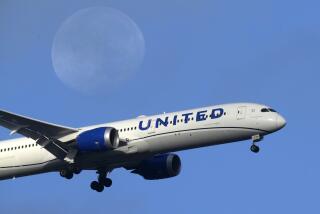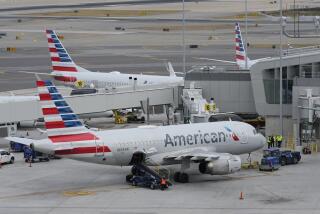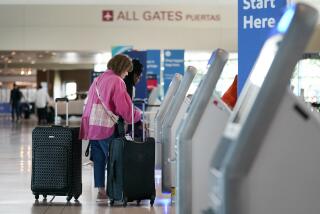Coping With Higher Prices of Frequent Flier Programs : Airlines: Less-generous mileage awards take effect Jan. 1. The remaining bargains will demand smarter planning.
With the coming of the new year, travelers who are members of frequent-flier programs confront significant changes--some immediate--in their mileage accounts.
First, billions of miles will expire from membersâ accounts at several airlinesâ frequent flier programs on Dec. 31. Several years ago, a number of carriers (including Alaska, American and United) instituted three-year time limits on accrued mileage. Therefore, miles earned on these programs in 1991 will expire at the end of 1994.
Second, in early 1995 most airlines (including American, Continental, United and USAir) are raising the âpriceâ of a free coach ticket within the continental United States and Canada, from 20,000 to 25,000 miles (an estimated 90% of all awards redeemed are for these types of tickets). USAir makes the change after midnight on Jan. 1. American, Continental and United follow on Feb. 1.
On the plus side, Delta is decreasing miles needed for a free coach ticket, from 30,000 miles to 25,000 starting May 1, 1995. Thatâs great for Delta fliers who have already accumulated mega-miles. But the carrier is also making it harder for members to earn miles on short flights. On May 1, Delta will lower minimum miles awarded on short hops, from 1,000 to 500 miles. For example, the 337-mile flight from LAX to San Francisco will earn 500 miles, not 1,000, as it used to.
At most carriers, the number of miles required for other awards will also change next year. Some awards, such as a free coach ticket to Hawaii, are going up on several airlines (on United, for example, mileage needed rises from 30,000 to 35,000). Others, such as two first-class tickets to Europe or Asia, will actually go down on some airlines later in 1995 (at American and United, the mileage cost drops from 200,000 to 160,000 miles for two tickets).
What should you do about expiring miles and redemption increases?
âDonât overreact to the changes,â says Randy Petersen, editor and publisher of âInsideFlyer,â a monthly consumer magazine for members of frequent flier programs.
âYes, (airlines) are boosting award redemption levels . . . but those deadlines donât mean you must fly before those dates to use the old redemption levels,â he says.
âFor example, if you want to get a ticket on United for 20,000 miles (or four 5,000 Mileage Plus award checks), make your travel plans and exchange your award checks for your ticket before Feb. 1,â he advises. âYour ticket will be valid for one year. You can change your travel date on that itinerary for no fee (providing award seating is available). You can change your itinerary, within the awardâs same geographic restrictions, for a $35 fee.
âYou can follow a similar strategy to avoid American AAdvantageâs increase by receiving a certificate from their frequent flier department before the Feb. 1 deadline. The award will be good for one year, giving you plenty of time to book your free flight in 1995. If you still need more time, you can book a flight in late 1995 for up to 320 days in advance. In other words, an American 20,000-mile award that would have gone up to 25,000 miles on Feb. 1, 1995, can be flown late into 1996.â
The same basic strategy applies toward minimizing the impact of expiring miles. At American, for example, order your 20,000-mile award certificate before those miles expire on Dec. 31. With that certificate, you have a year to make reservations for your free flight.
What if you are just short of the magic mile level for a domestic coach ticket? âFirst, find out if your frequent flier program will let you go into negative flow,â advises Petersen. âAlthough they donât publicize this policy, American, Delta and United will sometimes allow you to go into negative mileage in order to claim an award, particularly if you are a good customer. Continental even allows you to purchase miles to reach a prize level.
There are other ways to boost your mileage total. âYou could rent a car for 500 to 1,000 miles,â Petersen says. âBut those miles might not appear in your account for some time. If you need to reach an award level quickly, think about applying over the telephone for an airline-affiliated credit card. The banks are on-line with the airlines. If you are approved, the enrollment bonus (typically 2,500 or 5,000 miles) should appear in your account right away.â
If youâre going to use your mileage for leisure travel, select your destinations wisely. Donât spend 20,000 miles on a ticket to San Francisco that can be purchased for about $100 round trip or less in advance. Use your free ticket on more expensive destinations, such as out-of-the-way cities with limited airline competition, hence higher-than-average fares.
You donât have to live on airplanes to reap the benefits of the frequent flier programs. In 1994, an estimated 40% of all miles were earned on the ground. And mileage opportunities have now expanded far beyond rental cars, hotels and credit cards.
For example, every time you spend more than $29.99 to send flowers by calling 800-FLOWERS, you will receive 300 miles from Unitedâs Mileage Plus. On Dec. 1, American AAdvantage began a dining program, whereby three miles are earned for every dollar (excluding gratuity, but including tax) spent at more than 2,000 restaurants nationwide.
Some of todayâs on-the-ground mileage offers are quite generous. Be approved for a Dinerâs Club card (annual fee: $80) and receive 10,000 miles in any major U.S. carrierâs mileage program. Send Delta a slide showing one of the carrierâs vacation destinations (preferably without people) before Dec. 31. If Delta uses the photo in one of its publications, youâll be 10,000 miles richer. (Telephone 800-323-2323 for information.)
Times Travel Writer Christopher Reynolds is on assignment.
More to Read
Sign up for The Wild
Weâll help you find the best places to hike, bike and run, as well as the perfect silent spots for meditation and yoga.
You may occasionally receive promotional content from the Los Angeles Times.






